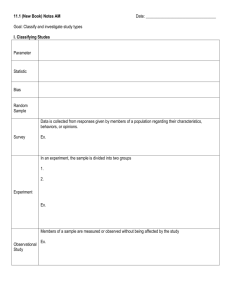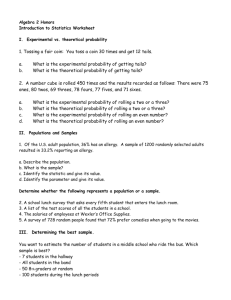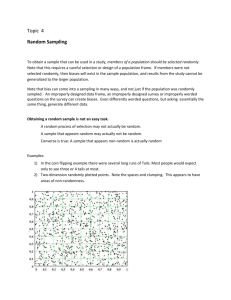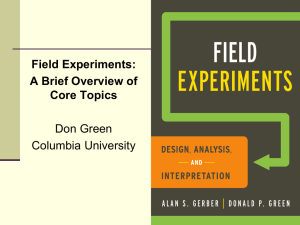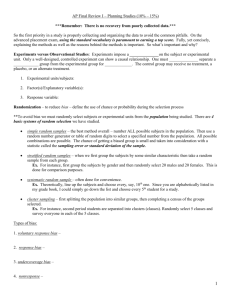Word
advertisement
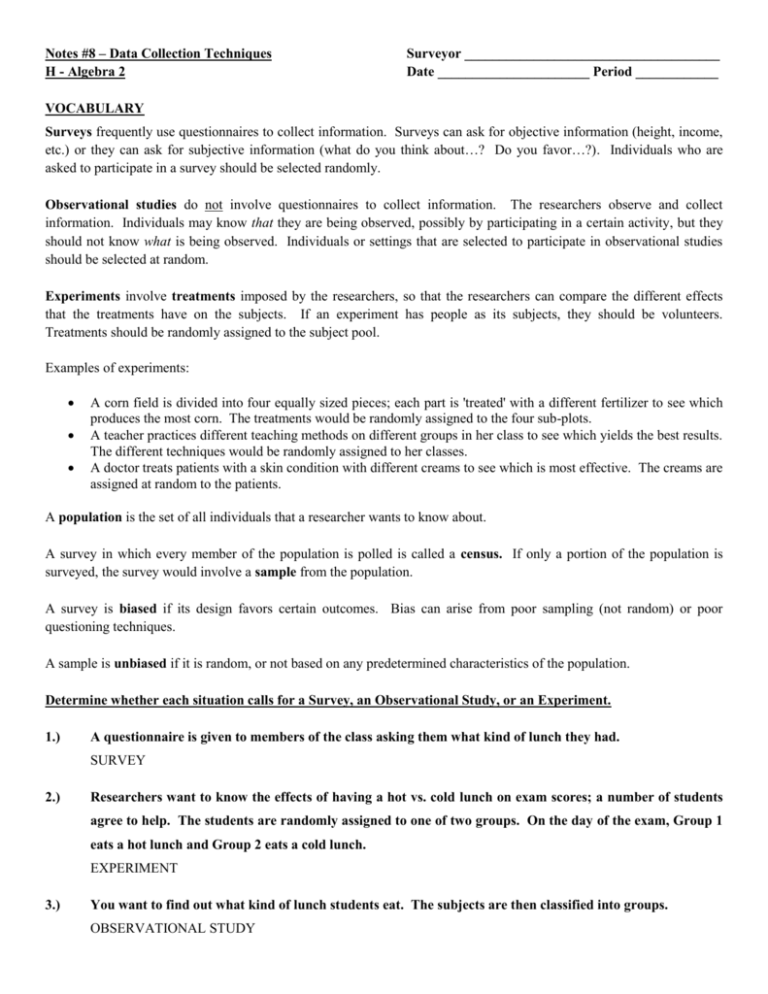
Notes #8 – Data Collection Techniques H - Algebra 2 Surveyor _____________________________________ Date ______________________ Period ____________ VOCABULARY Surveys frequently use questionnaires to collect information. Surveys can ask for objective information (height, income, etc.) or they can ask for subjective information (what do you think about…? Do you favor…?). Individuals who are asked to participate in a survey should be selected randomly. Observational studies do not involve questionnaires to collect information. The researchers observe and collect information. Individuals may know that they are being observed, possibly by participating in a certain activity, but they should not know what is being observed. Individuals or settings that are selected to participate in observational studies should be selected at random. Experiments involve treatments imposed by the researchers, so that the researchers can compare the different effects that the treatments have on the subjects. If an experiment has people as its subjects, they should be volunteers. Treatments should be randomly assigned to the subject pool. Examples of experiments: A corn field is divided into four equally sized pieces; each part is 'treated' with a different fertilizer to see which produces the most corn. The treatments would be randomly assigned to the four sub-plots. A teacher practices different teaching methods on different groups in her class to see which yields the best results. The different techniques would be randomly assigned to her classes. A doctor treats patients with a skin condition with different creams to see which is most effective. The creams are assigned at random to the patients. A population is the set of all individuals that a researcher wants to know about. A survey in which every member of the population is polled is called a census. If only a portion of the population is surveyed, the survey would involve a sample from the population. A survey is biased if its design favors certain outcomes. Bias can arise from poor sampling (not random) or poor questioning techniques. A sample is unbiased if it is random, or not based on any predetermined characteristics of the population. Determine whether each situation calls for a Survey, an Observational Study, or an Experiment. 1.) A questionnaire is given to members of the class asking them what kind of lunch they had. SURVEY 2.) Researchers want to know the effects of having a hot vs. cold lunch on exam scores; a number of students agree to help. The students are randomly assigned to one of two groups. On the day of the exam, Group 1 eats a hot lunch and Group 2 eats a cold lunch. EXPERIMENT 3.) You want to find out what kind of lunch students eat. The subjects are then classified into groups. OBSERVATIONAL STUDY 4.) You want to test a new treatment for a disease against an old treatment and a placebo. EXPERIMENT 5.) You want to find opinions on a presidential election. SURVEY 6.) You want to find out if 10 years of smoking affects lung capacity. OBSERVATIONAL STUDY – So why isn’t this an experiment? We want to know the differences in lung capacities between 10 year smokers and non-smokers. Don’t those sound like treatments? They could be, if it was ethical to force someone to smoke for 10 years. It is unethical to impose a treatment that is accepted, or even suspected, as being hazardous to one’s health. BIASED VS. UNBIASED State whether each survey would produce a random sample. Write BIASED or UNBIASED. Explain. 7.) You ask every tenth person coming out of a theater how many times per month they attend a theatrical performance to determine how often city residents support the performing arts. BIASED. By only asking people coming out of a theater, we are more likely to get an overestimate of how often residents attend the theater. Not all residents have equal opportunity to participate in this survey, and we will very likely not get any responses that say “never”. 8.) You survey people going into a pet store to find out if the city’s residents support the building and maintaining of a dog park. BIASED. People who shop at pet stores most likely have pets, which may include a dog. We are likely to get an overestimation of residents who support the building of a dog park because we are only asking people who are more likely to own a dog. Not every resident has equal opportunity to participate in this study. 9.) A box contains the name of every student in the school. A hundred names are randomly pulled out of the box. Those students are asked their opinions on the new cafeteria rules. UNBIASED. All individuals in the entire population (people we want to know about) have equal opportunity to participate in the survey. 10.) You ask every player at a golf course what sport they prefer to watch on TV. BIASED. Not every individual in the population has equal opportunity to participate in the study. We are likely to get an overestimate of what percentage of people prefer to watch golf on TV. 11.) Calling 100 randomly selected numbers and asking for their opinions on a local tax. UNBIASED. Each resident has equal opportunity to participate in this study (if we assume all residents own a phone).
